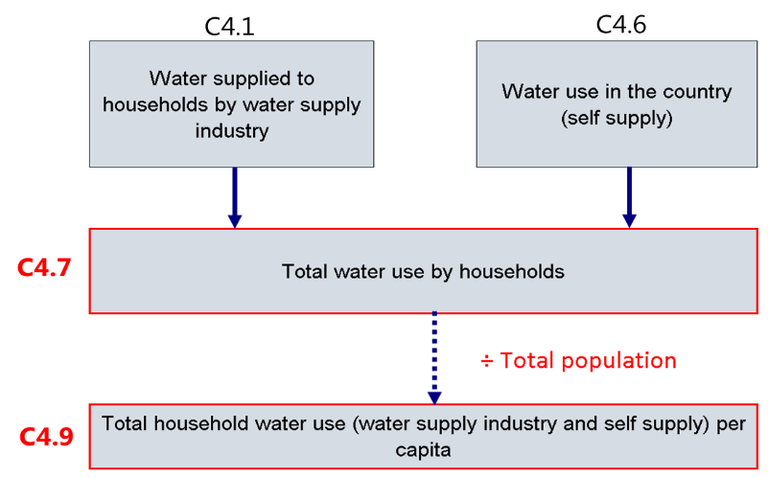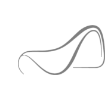C4 – Household water use per capita in the Republic of Azerbaijan
KEY MESSAGES
A citizen of Azerbaijan used an average of 108.2 m3 of water for household uses from renewable freshwater resources in 2005 compared with 73.6 m3 in 2017.
The population connected to the water supply has increased from 41.6 % in 2005 to 51 % in 2017 while water use per capita has decreased by 31.9 % for the same period, which indicates absolute decoupling.
However, 49 % of the total population has to meet its water demand by self-supply and is not yet connected to the water supply system, which keeps Azerbaijan far from reaching the United Nations (UN) Sustainable Development Goal (SDG) target 6.1 of, by 2030, achieving universal and equitable access to safe and affordable drinking water for all.
In 2017, water abstraction for households per capita on a daily basis was estimated at an average of 201.6 l/person per day.
Is household water use per capita decreasing in the Republic of Azerbaijan?
Figure 1 - Development of total freshwater use by households in the Republic of Azerbaijan (2000-2017)
Data sources:
9.1 Main indicators characterizing protection of water resources and their rational use provided by State Statistical Committee of the Republic of AzerbaijanFigure 2 - Development of household water use per capita in the Republic of Azerbaijan (2005-2017)
Data sources:
009_1en Main indicators characterizing protection of water resources and their rational use provided by State Statistical Committee of the Republic of Azerbaijan
Azerbaijan is experiencing water stress conditions with an annual water exploitation index of greater than 40 %. The annual average of the dependency ratio of Azerbaijan to external inflow is also estimated to be relatively high (63 %). On average, every year, around 10 000 million m3 of water is used to meet the water demand of different economic sectors, of which 3 % is used for households from the water supply system.
Water supplied to households is mainly used for drinking and cooking and for hygiene, including basic needs for personal and domestic cleanliness and amenity use such as car washing, lawn watering, etc. (Howard and Bartram, 2003).
As a result of investments in the water supply network (UNECE, 2011), the population connected to the water supply has increased by 9.3 % from 2005 (41.6 %) to 2017 (50.9 %). For the same period, water use per capita has decreased by 31.9 %. The increase in the total population in Azerbaijan and the substantial decrease in water use per capita over time indicates an absolute decoupling of population and water use. However, 49 % of the total population has to meet its water demand by self-supply and is not yet connected to the water supply system, which keeps Azerbaijan far from reaching UN SDG target of 6.1 of, by 2030, achieving universal and equitable access to safe and affordable drinking water for all.
In 2017, water use for households per capita on a daily basis was estimated at an average of 201.6 l/person per day.
Indicator specification
Indicator definition
The quantity of water used to cover the household and related utility needs of the population through the water supply industry and self-supply.Units
Volumes of water used by households in total are measured in million cubic metres and per capita in cubic meter.Rationale
Justification for indicator selection
The indicator is important for defining the level of development of the water economy services and the degree of water accessibility to cover all of the household needs of the population. The indicator also helps to identify trends in household water use in a particular country.Scientific references
- Howard, G. and Bartram, J., 2003. Domestic Water Quantity, Service Level and Health. World Health Organization, WHO/SDE/WSH/03.02, Geneva, Switzerland.
- UNECE, 2011. Azerbaijan –Second Environmental Performance Review, United Nations Economic Commission for Europe, Environmental Performance Reviews Series No. 31, e-ISBN 978-92-1-117035-1, New York and Geneva.
- UNECE, 2018. Guidelines for the Application of Environmental Indicators, Description of C4: Household water use per capita.
- UNECE, 2018. Guidelines for the Application of Environmental Indicators, Glossary of terms – C4: Household water use per capita.
Policy context and targets
Context description
National policy context
Azerbaijan is a signatory party to numerous conventions and partnerships that are relevant to the water and sanitation sector, including the Helsinki Convention on the Protection and Use of Transboundary Watercourses and International Lakes and the Protocol on Water and Health of this Convention.International policy context
The UN SDG 6 of the Sustainable Development Agenda for the period up to 2030 is to ‘ensure access to water and sanitation for all’. Target 6.1 of SDG 6 aims ‘by 2030, to achieve universal and equitable access to safe and affordable drinking water for all’. Similarly, target 6.2 aims to, ‘by 2030, achieve access to adequate and equitable sanitation and hygiene for all and end open defecation, paying special attention to the needs of women and girls and those in vulnerable situations.’Targets
No specific target has been identified.Related policy documents
- The water code of the Azerbaijan Republic, 1997. Adopted by the Law of Azerbaijan Republic № 418-IG of December 26, 1997.
- Sustainable Development Goals. UN (2016). Sustainable development goals, the sustainable development agenda.
Methodology
Methodology for indicator calculation

Units and equations
| ID | Component | Units | Equation |
|
C4.1 |
Water supplied to households by water supply industry |
million m3/year |
|
|
C4.2 |
Population connected to water supply industry (estimation) |
million persons |
|
|
C4.3 |
Water use per capita (water supply industry) |
m3/capita/year |
= C 4.1/C 4.2 |
|
C4.4 |
Population not connected to water supply industry (self-supply; estimation) |
million persons |
= C 4.8 - C 4.2 |
|
C4.5 |
Estimated water use by households supplied by self-supply per capita |
m3/capita/year |
|
|
C4.6 |
Water use in the country (self-supply) |
million m3/year |
= C 4.4 C 4.5 |
|
C4.7 |
Total water use by households |
million m3/year |
=C 4.1 + C 4.6 |
|
C4.8 |
Total population |
million persons |
|
|
C4.9 |
Total household water use (water supply industry and self-supply) per capita |
m3/capita/year |
=C 4.7/C 4.8 |
Methodology for gap filling
No gap filling has been performedMethodology references
- EEA, 2005. EEA core set of indicators guide. EEA Technical report No 1/2005, ISBN 92-9167-757-4, Luxembourg.
- UNECE, 2018. Guidelines for the Application of Environmental Indicators, Data template – C4: Household water use per capita.
- UNECE, 2018. Guidelines for the Application of Environmental Indicators, Description of C4: Household water use per capita.
- UNECE, 2018. Guidelines for the Application of Environmental Indicators, Glossary of terms – C4: Household water use per capita.
- UNSD and UNEP, 2013. Questionnaire 2013 on Environment Statistics. United Nations Statistics Division and United Nations Environment Programme, Questionnaire 2013 on Environment Statistics, Section Water.
Uncertainties
Methodology uncertainty
No uncertainty has been specified.Data sets uncertainty
No data are available on self-supply water use by households. Hence, the assessment in this indicator is not fully reliable in addressing the current state of household water use per capita.Rationale uncertainty
No uncertainty has been specified.Data sources
- Gross Domestic Products provided by World Bank
- 9.1. Main indicators characterizing protection of water resources and their rational use provided by the State Statistical Committee of the Republic of Azerbaijan
- 9.3. Main indicators characterizing water resources by types of economic activities provided by the State Statistical Committee of the Republic of Azerbaijan
Metadata
Topics: waterIndicator code: C4
Tags: water use, water use per capita, Azerbaijan
Temporal coverage: 2000-2017
DPSIR: pressure
Typology: descriptive indicator (type A – what is happening to the environment and to humans?)
Dates
Publication date:Last modified:
Frequency of updates: every year
Contact and ownership
Contact: Rena Lazımova (Statistical Committee) and Tural Agharzayev (Azersu OJSC)Ownership: State Statistical Committee of the Republic of Azerbaijan





